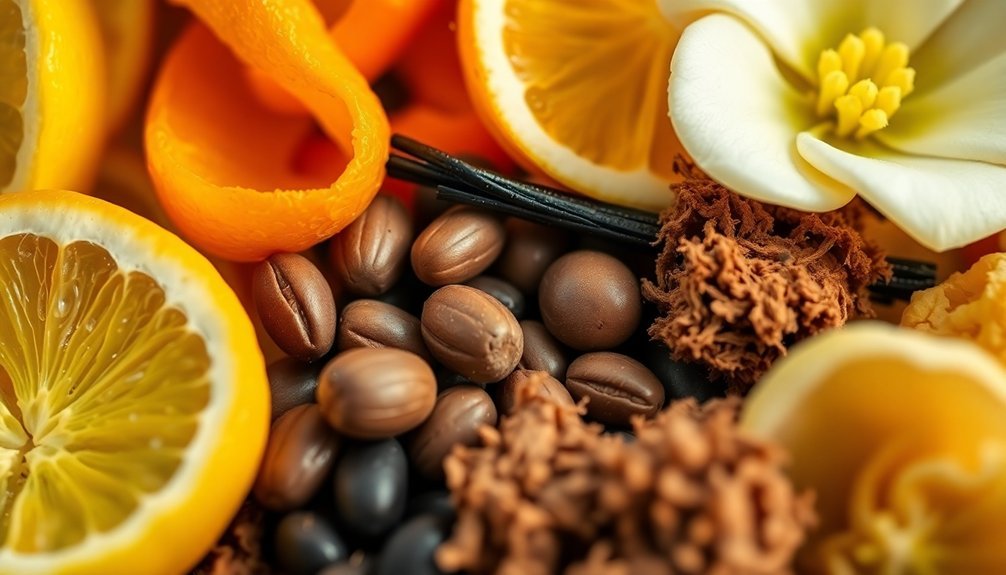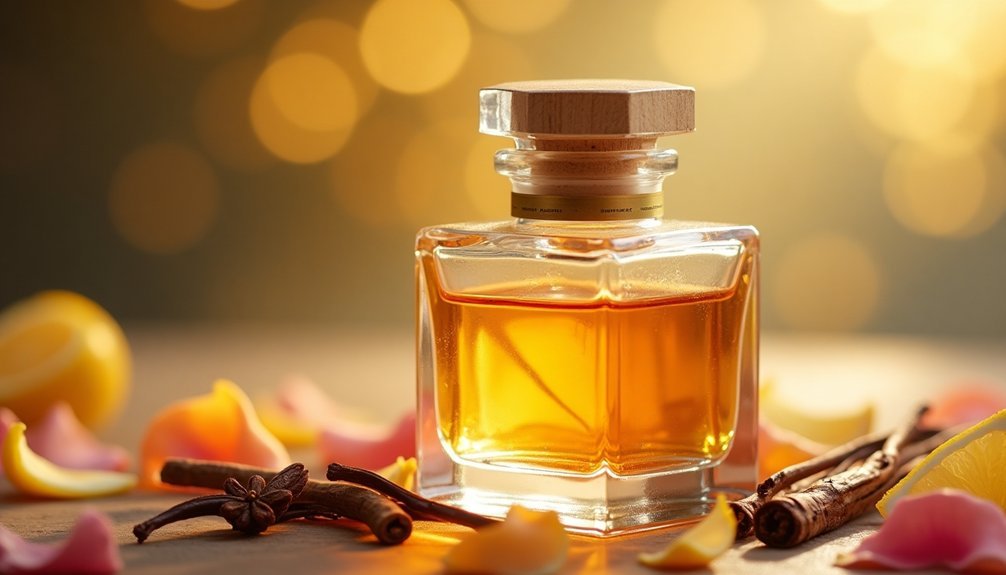Perfume notes are fragrance components that unfold in distinct layers over time. You'll experience the bright top notes first, which last 5-15 minutes with crisp citrus and herb scents. Middle notes emerge next, blooming for 20-60 minutes with florals and spices. Base notes anchor the fragrance for 6+ hours using rich ingredients like vanilla and musk. Understanding these categories helps you select fragrances that match your desired scent journey.
The Science Behind Fragrance Note Classification

When you explore the science of fragrance notes, you'll find that their classification stems from precise molecular characteristics and evaporation rates.
The structure is remarkably systematic: small molecules evaporate quickly to form top notes that last 5-15 minutes, while medium-sized molecules create middle notes lasting 20-60 minutes. The largest molecules compose base notes, which can linger for six hours or more.
You can observe this scientific principle in action through common ingredients.
Citrus oils like limonene represent top notes with their light molecules, while lavender's linalool falls into the middle category. Heavy molecules like vanillin from vanilla exemplify base notes. Natural perfumes offer safer alternatives to conventional fragrances that often contain harmful chemicals like DEP.
This molecular hierarchy creates the foundational structure that perfumers use to craft fragrances that evolve beautifully on your skin.
Decoding Top Notes: The First Impression
When you first spray a perfume, you'll experience the bright, fresh top notes that create your initial impression of the fragrance.
These opening notes typically feature citrus, light florals, or crisp herbs that grab your attention and set the stage for the fragrance's journey. Top notes are composed of smaller volatile molecules that evaporate quickly upon application.
You'll notice these top notes fade quickly, usually within 5-15 minutes, as they shift into the fragrance's heart notes.
Fresh, Bright Opening Notes
Anyone who's experienced fine perfumes knows that the initial burst of fragrance creates a powerful first impression. These fresh, bright opening notes typically feature citrus oils, herbs, and light florals that immediately grab your attention and set the tone for the entire fragrance experience. Dating back to the 18th century, Eau de Cologne pioneered the sophisticated use of citrus notes like lemon, orange, neroli and bergamot.
| Top Note Type | Common Examples |
|---|---|
| Citrus | Bergamot, Lemon, Orange |
| Herbal | Basil, Mint, Anise |
| Light Floral | Lavender, Rose |
You'll notice these top notes are invigorating and uplifting, lasting just long enough to shift smoothly into the middle notes. While citrus adds a crisp, fresh element, green notes can evoke freshly cut grass or crushed leaves. When properly balanced, these opening notes work harmoniously with the rest of the perfume's composition to create a memorable fragrance journey.
Quick Evaporation Timeline
Understanding a perfume's top notes requires familiarity with their quick evaporation timeline. When you spray a fragrance, the top notes are the first scents you'll experience, but they won't stick around for long.
These volatile compounds typically fade within 5-15 minutes, though some can last up to two hours.
You'll notice that top notes often feature light, bright scents like citrus, fresh herbs, or spicy elements. Common ingredients include lemon, bergamot, lavender, cardamom, and jasmine sambac.
Their quick disappearance serves a purpose in the fragrance pyramid – they create your first impression and set the stage for the middle notes to emerge.
Despite their brief appearance, these headnotes play a significant role in shaping your initial experience with the fragrance.
Middle Notes: The Heart of Your Perfume

After the initial burst of top notes fades, middle notes emerge to form the true heart of your perfume. These notes dominate your fragrance for 20-60 minutes, creating a seamless bridge between the fresh opening and the rich base notes.
You'll find that middle notes are more mellow and rounded, giving your scent its distinctive character and depth.
The heart notes typically include:
- Luxurious florals like rose, jasmine, and lavender
- Warm spices such as cinnamon and cardamom
- Aromatic herbs including sweet marjoram and fennel
- Light woods and dark fruits
- Calming compounds like linalool
These middle notes are essential in maintaining your fragrance's harmony and complexity.
They'll work continuously to guarantee your perfume remains engaging while setting the stage for the lasting base notes to emerge.
Base Notes: Building a Lasting Foundation
Base notes form the strong, lasting core of your perfume, with woods like sandalwood and cedar, musks, amber, resins, and patchouli being among the most widely used ingredients.
You'll find these deep, rich elements working together to create a harmonious foundation that anchors your fragrance's overall composition.
When these base notes complement each other effectively, they'll provide the lasting impression that defines your signature scent long after the top and middle notes have faded.
Most Common Base Notes
Deep within every memorable perfume lies a foundation of base notes that shape its lasting identity.
These rich, complex notes are the least volatile components, lingering on your skin for six hours or more. You'll find that base notes serve as anchors, enhancing both the fragrance's complexity and its wear time.
The most common base notes fall into distinct categories, each bringing unique qualities to your perfume:
- Woody notes like sandalwood and cedarwood provide earthy depth
- Vanilla and amber offer warm, sweet comfort
- Musk helps extend the fragrance's longevity
- Patchouli and vetiver contribute herbal earthiness
- Leather and moss add natural, raw character
Understanding these base notes helps you choose fragrances that match your desired longevity and personality, as they'll be the scents that linger longest on your skin.
Creating Base Note Harmony
Creating a harmonious foundation with base notes requires careful consideration of how different scent elements interact and evolve together. You'll need to understand how ingredients like patchouli, amber, and musk work with each other to create a lasting impression that can persist for several hours on your skin.
When combining base notes, focus on achieving a seamless shift from the middle notes while maintaining the fragrance's overall integrity. Popular combinations include white musk with cedar wood and amber, or vanilla with praline for added warmth.
The key is to guarantee these components, which make up 10-25% of the total aroma, complement rather than compete with each other. Remember that base notes aren't just about longevity – they're essential for bridging the entire fragrance composition and creating a deep, rich foundation that anchors your scent.
Essential Ratios for Perfect Note Balance

The art of perfume blending hinges on achieving precise ratios between different fragrance notes. While traditional guidelines suggest using 30% top notes, 45% middle notes, and 25% base notes, you'll find that these proportions can be adjusted to match your vision.
You can experiment with alternative ratios like 1:1:1 or 3:2:1 to create your desired scent profile.
- Top notes evaporate within 15-30 minutes, creating your first impression
- Middle notes form the fragrance's heart, emerging as top notes fade
- Base notes provide longevity and establish the final character
The 30-45-25 ratio serves as a reliable starting point.
Personal preference should guide your ratio adjustments.
Remember that while these ratios provide a foundation, perfume creation remains a subjective art that welcomes experimentation and creativity.
Blending Techniques Across Note Categories
When you're blending perfume notes, you'll want to start with your top notes and gradually layer in middle and base notes to create a harmonious, long-lasting fragrance.
To achieve balance, follow the classic proportion rule where top notes comprise 15-25%, middle notes 30-40%, and base notes 40-55% of your total blend.
You can perfect your blend through methodical drop-by-drop additions while testing on fragrance strips to evaluate how the different note categories interact and evolve together.
Layering For Lasting Scents
Skillful fragrance layering transforms a simple scent into a complex, long-lasting signature aroma that evolves throughout the day.
Start with clean, hydrated skin and build your layers strategically, beginning with the strongest notes first. You'll want to apply scented body wash, followed by complementary lotions and perfume oils before finishing with your eau de parfum.
- Apply fragrances to pulse points where body heat naturally amplifies the scent
- Use a fragrance primer to create a neutral foundation for blending
- Layer lighter notes on top of bolder base scents to prevent overwhelming
- Adjust your combinations seasonally – fresh blends for summer, warm notes for winter
- Consider spritzing your hair ends or scarf for an extra diffusion of fragrance
When done correctly, you'll create a harmonious blend that unfolds beautifully throughout wear time.
Proportion Rules For Harmony
Creating harmonious perfume blends relies on understanding the golden ratio of fragrance composition: 20% top notes, 30% middle notes, and 50% base notes.
You'll achieve the most balanced results by following this time-tested proportion.
When blending, you'll find that notes within the same category naturally complement each other. Top notes mix well with other top notes, while middle and base notes follow the same principle.
For cross-category blending, universal fragrances like citrus and clean scents are your safest bet, as they'll work with almost anything. However, you'll need to be more careful when mixing fragrant heart notes with base accents.
To perfect your blend, use fragrance strips for testing and allow several days for the scent to mature.
Don't forget to clear your nose with coffee beans between tests.
The Art of Note Recognition

The ability to recognize perfume notes resembles learning a new language, where each scent tells its own unique story.
You'll need to train your nose to identify different notes as they emerge during the fragrance's evolution. Start by using smelling strips and taking time to experience how the scent changes from top notes to base notes.
- Fresh, citrusy notes burst forth immediately and fade quickly
- Floral notes bloom in the heart of the fragrance
- Spicy notes add warmth and complexity throughout
- Woody notes ground the scent and last the longest
- Musky notes create a lasting impression as base notes
For best results, don't overwhelm your senses by testing too many fragrances at once.
Instead, select a few samples to wear over time, keeping track of the notes you enjoy most in a fragrance chart.
Common Ingredients in Each Note Category
Perfume ingredients fall into three distinct note categories, each playing an essential role in a fragrance's development over time.
Top notes feature bright, energetic ingredients like bergamot, lemon, and black pepper that create an immediate impression but fade quickly. You'll find these zesty elements providing the initial burst of freshness.
Middle notes, also known as the heart, contain floral and herbal elements like jasmine, geranium, and clary sage. They emerge as the top notes dissipate, forming the fragrance's core character.
Base notes anchor the entire composition with rich, enduring ingredients such as amber, vanilla, and sandalwood. These deep, warm elements provide longevity and depth to the perfume.
Some versatile ingredients like ambrette and galbanum can work across multiple note categories, adding complexity to the fragrance.
Creating Harmony Between Note Layers

Understanding how notes interact with each other is fundamental to achieving a balanced fragrance that develops beautifully over time.
You'll want to blend your fragrances using proven ratios like 1:1:1 or 3:2:1 for top, middle, and base notes. Start with a drop-by-drop approach, keeping detailed records of your combinations. Test how the scents evolve together on your skin throughout the day, as personal body chemistry plays an essential role in the final outcome.
- Match the intensity of each note layer to avoid overwhelming or weak spots
- Layer different forms of fragrance (sprays, oils, lotions) to create depth
- Consider seasonal appropriateness when selecting note combinations
- Use neutral body products to prevent clashing with your perfume blend
- Allow time for testing and adjusting until you find your perfect balance
Note Categories in Popular Fragrance Families
Modern fragrance families encompass distinct categories that help perfumers and enthusiasts classify and understand different scent profiles.
You'll find four main families: floral, oriental, woody, and fresh, each with unique subfamilies and characteristics.
The floral family features sweet, powdery notes like rose and jasmine, often combined with fruity elements.
Oriental fragrances offer warm, spicy combinations of vanilla, myrrh, and exotic resins.
You'll recognize woody scents by their rich, earthy profiles of sandalwood, cedarwood, and patchouli.
Fresh fragrances round out the categories with invigorating citrus, aromatic herbs, and aquatic notes.
Each family serves different purposes – florals shine in spring and summer, while oriental and woody scents suit cooler seasons.
Understanding these categories helps you navigate the complex world of perfume notes.
Frequently Asked Questions
Can Perfume Notes Change Based on Skin Chemistry and Temperature?
Yes, your skin's unique chemistry and temperature will change how perfume notes develop. Your body's natural oils, pH levels, sweat, and the ambient heat all affect how fragrances evolve on your skin.
How Do Different Storage Conditions Affect the Longevity of Perfume Notes?
Your perfume's notes will last longer when you store it in cool, dark places with minimal air exposure. Heat, light, and improper sealing can degrade all notes, particularly affecting the delicate top notes first.
Why Do Some People Smell Different Notes Than Others?
You'll smell different notes than others due to your unique biology, genetics, and personal experiences. Your cultural background, age, and even hormones affect how your nose interprets scents differently from someone else's.
What Role Does Humidity Play in How Perfume Notes Develop?
You'll notice that high humidity slows down your perfume's evaporation, making all notes last longer. It helps top notes linger, middle notes unfold smoothly, and base notes develop more fully throughout wear.
Can Certain Medications Affect How Perfume Notes Are Perceived?
Yes, your medications can greatly alter how you perceive perfume notes. They'll affect your body chemistry, olfactory system, and skin pH, which means you might experience fragrances differently than someone who's not taking medications.
In Summary
Understanding perfume notes doesn't have to be complicated. You'll find that knowing the interplay between top, middle, and base notes will transform how you select and appreciate fragrances. Whether you're a casual wearer or aspiring perfumer, this knowledge lets you decode scents like a pro. Start paying attention to how notes unfold on your skin, and you'll discover a whole new dimension of fragrance appreciation.





Leave a Reply